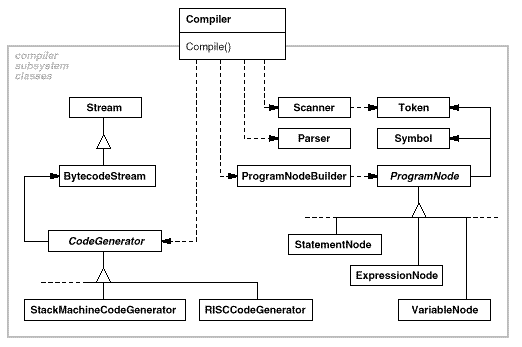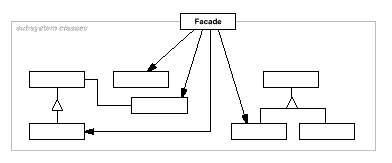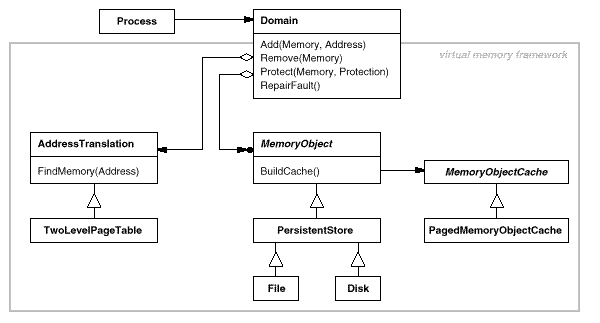 Intent
Intent Intent
IntentProvide a unified interface to a set of interfaces in a subsystem. Facade defines a higher-level interface that makes the subsystem easier to use.
 Motivation
MotivationStructuring a system into subsystems helps reduce complexity. A common design goal is to minimize the communication and dependencies between subsystems. One way to achieve this goal is to introduce a facade object that provides a single, simplified interface to the more general facilities of a subsystem.

Consider for example a programming environment that gives applications access to its compiler subsystem. This subsystem contains classes such as Scanner, Parser, ProgramNode, BytecodeStream, and ProgramNodeBuilder that implement the compiler. Some specialized applications might need to access these classes directly. But most clients of a compiler generally don't care about details like parsing and code generation; they merely want to compile some code. For them, the powerful but low-level interfaces in the compiler subsystem only complicate their task.
To provide a higher-level interface that can shield clients from these classes, the compiler subsystem also includes a Compiler class. This class defines a unified interface to the compiler's functionality. The Compiler class acts as a facade: It offers clients a single, simple interface to the compiler subsystem. It glues together the classes that implement compiler functionality without hiding them completely. The compiler facade makes life easier for most programmers without hiding the lower-level functionality from the few that need it.

 Applicability
ApplicabilityUse the Facade pattern when
 Structure
Structure
 Participants
Participants Collaborations
Collaborations Consequences
ConsequencesThe Facade pattern offers the following benefits:
Reducing compilation dependencies is vital in large software systems. You want to save time by minimizing recompilation when subsystem classes change. Reducing compilation dependencies with facades can limit the recompilation needed for a small change in an important subsystem. A facade can also simplify porting systems to other platforms, because it's less likely that building one subsystem requires building all others.
 Implementation
ImplementationConsider the following issues when implementing a facade:
An alternative to subclassing is to configure a Facade object with different subsystem objects. To customize the facade, simply replace one or more of its subsystem objects.
The public interface to a subsystem consists of classes that all clients can access; the private interface is just for subsystem extenders. The Facade class is part of the public interface, of course, but it's not the only part. Other subsystem classes are usually public as well. For example, the classes Parser and Scanner in the compiler subsystem are part of the public interface.
Making subsystem classes private would be useful, but few object-oriented languages support it. Both C++ and Smalltalk traditionally have had a global name space for classes. Recently, however, the C++ standardization committee added name spaces to the language [Str94], which will let you expose just the public subsystem classes.
 Sample Code
Sample CodeLet's take a closer look at how to put a facade on a compiler subsystem.
The compiler subsystem defines a {BytecodeStream} class that
implements a stream of Bytecode objects. A
Bytecode object encapsulates a bytecode, which can specify machine
instructions. The subsystem also defines a Token class for
objects that encapsulate tokens in the programming language.
The Scanner class takes a stream of characters and produces
a stream of tokens, one token at a time.
class Scanner {
public:
Scanner(istream&);
virtual ~Scanner();
virtual Token& Scan();
private:
istream& _inputStream;
};
The class Parser uses a ProgramNodeBuilder to construct a
parse tree from a Scanner's tokens.
class Parser {
public:
Parser();
virtual ~Parser();
virtual void Parse(Scanner&, ProgramNodeBuilder&);
};
Parser calls back on ProgramNodeBuilder to build
the parse tree incrementally. These classes interact according to the
Builder (97) pattern.
class ProgramNodeBuilder {
public:
ProgramNodeBuilder();
virtual ProgramNode* NewVariable(
char* variableName
) const;
virtual ProgramNode* NewAssignment(
ProgramNode* variable, ProgramNode* expression
) const;
virtual ProgramNode* NewReturnStatement(
ProgramNode* value
) const;
virtual ProgramNode* NewCondition(
ProgramNode* condition,
ProgramNode* truePart, ProgramNode* falsePart
) const;
// ...
ProgramNode* GetRootNode();
private:
ProgramNode* _node;
};
The parse tree is made up of instances of ProgramNode
subclasses such as StatementNode,
ExpressionNode, and so forth. The ProgramNode
hierarchy is an example of the Composite (163)
pattern. ProgramNode defines an interface for manipulating
the program node and its children, if any.
class ProgramNode {
public:
// program node manipulation
virtual void GetSourcePosition(int& line, int& index);
// ...
// child manipulation
virtual void Add(ProgramNode*);
virtual void Remove(ProgramNode*);
// ...
virtual void Traverse(CodeGenerator&);
protected:
ProgramNode();
};
The Traverse operation takes a CodeGenerator
object. ProgramNode subclasses use this object to generate
machine code in the form of Bytecode objects on a
BytecodeStream. The class CodeGenerator is a
visitor (see Visitor (331)).
class CodeGenerator {
public:
virtual void Visit(StatementNode*);
virtual void Visit(ExpressionNode*);
// ...
protected:
CodeGenerator(BytecodeStream&);
protected:
BytecodeStream& _output;
};
CodeGenerator has subclasses, for example,
StackMachineCodeGenerator and RISCCodeGenerator,
that generate machine code for different hardware architectures.
Each subclass of ProgramNode implements Traverse
to call Traverse on its child ProgramNode
objects. In turn, each child does the same for its children, and so
on recursively. For example, ExpressionNode defines
Traverse as follows:
void ExpressionNode::Traverse (CodeGenerator& cg) {
cg.Visit(this);
ListIterator i(_children);
for (i.First(); !i.IsDone(); i.Next()) {
i.CurrentItem()->Traverse(cg);
}
}
The classes we've discussed so far make up the compiler subsystem.
Now we'll introduce a Compiler class, a facade that puts all
these pieces together. Compiler provides a simple interface
for compiling source and generating code for a particular machine.
class Compiler {
public:
Compiler();
virtual void Compile(istream&, BytecodeStream&);
};
void Compiler::Compile (
istream& input, BytecodeStream& output
) {
Scanner scanner(input);
ProgramNodeBuilder builder;
Parser parser;
parser.Parse(scanner, builder);
RISCCodeGenerator generator(output);
ProgramNode* parseTree = builder.GetRootNode();
parseTree->Traverse(generator);
}
This implementation hard-codes the type of code generator to use so
that programmers aren't required to specify the target architecture.
That might be reasonable if there's only ever one target architecture.
If that's not the case, then we might want to change the
Compiler constructor to take a CodeGenerator
parameter. Then programmers can specify the generator to use when
they instantiate Compiler. The compiler facade can
parameterize other participants such as Scanner and
ProgramNodeBuilder as well, which adds flexibility, but it also
detracts from the Facade pattern's mission, which is to simplify the
interface for the common case.
 Known Uses
Known UsesThe compiler example in the Sample Code section was inspired by the ObjectWorks\Smalltalk compiler system [Par90].
In the ET++ application framework [WGM88], an application can have built-in browsing tools for inspecting its objects at run-time. These browsing tools are implemented in a separate subsystem that includes a Facade class called "ProgrammingEnvironment." This facade defines operations such as InspectObject and InspectClass for accessing the browsers.
An ET++ application can also forgo built-in browsing support. In that case, ProgrammingEnvironment implements these requests as null operations; that is, they do nothing. Only the ETProgrammingEnvironment subclass implements these requests with operations that display the corresponding browsers. The application has no knowledge of whether a browsing environment is available or not; there's abstract coupling between the application and the browsing subsystem.
The Choices operating system [CIRM93] uses facades to compose many frameworks into one. The key abstractions in Choices are processes, storage, and address spaces. For each of these abstractions there is a corresponding subsystem, implemented as a framework, that supports porting Choices to a variety of different hardware platforms. Two of these subsystems have a "representative" (i.e., facade). These representatives are FileSystemInterface (storage) and Domain (address spaces).

For example, the virtual memory framework has Domain as its facade. A Domain represents an address space. It provides a mapping between virtual addresses and offsets into memory objects, files, or backing store. The main operations on Domain support adding a memory object at a particular address, removing a memory object, and handling a page fault.
As the preceding diagram shows, the virtual memory subsystem uses the following components internally:
The RepairFault operation is called whenever a page fault interrupt occurs. The Domain finds the memory object at the address causing the fault and delegates the RepairFault operation to the cache associated with that memory object. Domains can be customized by changing their components.
 Related Patterns
Related PatternsAbstract Factory (87) can be used with Facade to provide an interface for creating subsystem objects in a subsystem-independent way. Abstract Factory can also be used as an alternative to Facade to hide platform-specific classes.
Mediator (273) is similar to Facade in that it abstracts functionality of existing classes. However, Mediator's purpose is to abstract arbitrary communication between colleague objects, often centralizing functionality that doesn't belong in any one of them. A mediator's colleagues are aware of and communicate with the mediator instead of communicating with each other directly. In contrast, a facade merely abstracts the interface to subsystem objects to make them easier to use; it doesn't define new functionality, and subsystem classes don't know about it.
Usually only one Facade object is required. Thus Facade objects are often Singletons (127).